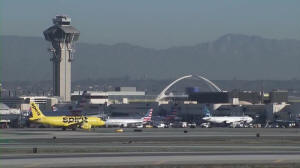U.S. FAA clears 45% of commercial plane fleet after 5G deployed
 Send a link to a friend
Send a link to a friend
 [January 17, 2022]
By David Shepardson [January 17, 2022]
By David Shepardson
WASHINGTON (Reuters) - The U.S. Federal
Aviation Administration (FAA) said Sunday it had cleared an estimated
45% of the U.S. commercial airplane fleet to perform low-visibility
landings at many airports where 5G C-band will be deployed starting
Wednesday.
The FAA has warned that potential interference could affect sensitive
airplane instruments such as altimeters and make an impact on
low-visibility operations.
U.S. passenger and cargo airlines have been sounding the alarm to senior
government officials that the issue is far from resolved and could
severely impact flights and the supply chain.
"Even with the approvals granted by the FAA today, U.S. airlines will
not be able to operate the vast majority of passenger and cargo flights
due to the FAA's 5G-related flight restrictions unless action is taken
prior to the planned Jan. 19 rollout," said Airlines for America, a
trade group representing American Airlines, Delta Air Lines, Fedex and
other carriers.
The FAA approved two radio altimeter models used in many Boeing and
Airbus planes, including some Boeing 737, 747, 757, 767, MD-10/-11 and
Airbus A310, A319, A320, A321, A330 and A350 models. The announcement
came just days before AT&T and Verizon launch new 5G service on
Wednesday. The FAA said it expects to issue more approvals in the coming
days.

The FAA said the aircraft and altimeter approvals open "runways at as
many as 48 of the 88 airports most directly affected by 5G C-band
interference." But the agency warned that "even with these new
approvals, flights at some airports may still be affected."
Reuters reviewed the 36-page list of the runways covered by the
approvals that has not yet been made public - and it does not include
many larger U.S. airports.
[to top of second column]
|

The U.S. Federal Aviation Administration (FAA) said Sunday it had
cleared an estimated 45% of the U.S. commercial airplane fleet to
perform low-visibility landings at many airports where 5G C-band
will be deployed starting Wednesday.
 The FAA told Boeing in a letter
Sunday reviewed by Reuters that it was granting approvals for
specific runways and planes with certain altimeters "because the
susceptibility to interference from 5G C-band emissions has been
minimized."
AT&T and Verizon, which won nearly all of the C-Band spectrum in an
$80 billion auction last year, on Jan. 3 agreed to buffer zones
around 50 airports to reduce interference risks and take other steps
to reduce potential interference for six months. They also agreed to
delay deployment for two weeks, averting an aviation safety
standoff.
The FAA on Thursday issued nearly 1,500 notices detailing the extent
of potential impact of 5G services.
"Passengers should check with their airlines if weather is forecast
at a destination where 5G interference is possible," the FAA said
Sunday.
On Jan. 7, the FAA disclosed the 50 U.S. airports that will have 5G
buffer zones, including in New York City, Los Angeles, Chicago, Las
Vegas, Minneapolis, Detroit, Dallas, Philadelphia, Seattle and
Miami.
But airlines warn those buffer zones may not be enough to prevent
flight disruptions at those airports.
On Thursday, Airports Council International – North America urged a
delay 5G implementation to avoid widespread disruption across the
U.S air transportation system.
On Friday, the FAA said it would require Boeing 787 operators to
take additional precautions when landing on some wet or snowy
runways.
(Reporting by David Shepardson; Editing by Nick Zieminski and Gerry
Doyle)
[© 2022 Thomson Reuters. All rights
reserved.] This material may not be published,
broadcast, rewritten or redistributed.
Thompson Reuters is solely responsible for this content. |